Building a bigger, stronger back doesn’t always mean you need to hit the gym.
Chiseled, V-shaped lats (latissimus dorsi) contribute to that coveted inverted triangle look, but you don’t need a fully-equipped gym to work this major back muscle group.
While there are many lat exercises that can be done in a gym, there are also many effective lat exercises that you can do at home with minimal or no equipment.
In this post, I’ll share 10 of my favorite lat exercises that require little to no equipment. You can work out different parts of the lats using body weights, dumbbells, or resistance bands.

- Anatomy Of The Lats
- Lat Exercises at Home – No Equipment Needed
- 1. Pull Ups
- 2. Inverted Row
- 3. Superman
- 4. Side Plank Rotation
- 5. Supine Bodyweight Floor Row
- Lat Exercises at Home – Minimal Equipment Needed
- 6. Resistance Band Pull-Aparts
- 7. Bands Lat Pulldown
- 8. Face Pull with Resistance Band
- 9. Renegade Row
- 10. Single-arm Dumbbell Row
- Tips for Effective Lat Training at Home
- 1. Incorporate a variety of exercises
- 2. Consistent Training
- 3. Mind-Muscle Connection
- 4. Progressive Overload
- 5. Rest and Recovery
- At-Home Lats Workout Plan Without Equipment
- Lat Workout At Home With Resistance Band
- Conclusion
Anatomy Of The Lats
The back consists of several layers of muscle stacked like a sandwich. The muscles are subdivided into three categories.
- The upper back comprises a large triangular-shaped muscle called the trapezius.
- The middle back consists of the latissimus dorsi (Lats).
- The lower back is made up of the erector spine muscles.
The latissimus dorsi muscle, commonly known as the “lats,” is a large, triangular muscle in the upper back and sides of the torso.
The lats function to extend, adduct, and internally rotate the arm, stabilize the shoulder blade, and assist in spinal extension.
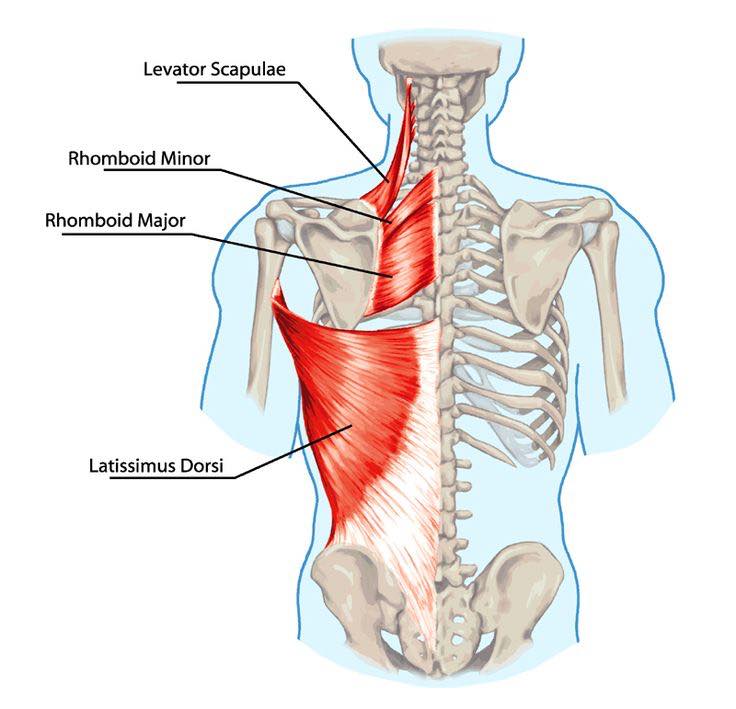
Want to take your gains to the next level? Discover your daily calorie needs with our free TDEE calculator
Lat Exercises at Home – No Equipment Needed
You don’t need a lot of machines or fancy equipment to get strong and defined lats. With just your own bodyweight, you can perform powerful lat exercises right in the comfort of your home.
These bodyweight exercises will help you build an impressive v-taper and wide back without equipment.
1. Pull Ups
Pull-ups are one of the best bodyweight exercises for building upper body strength. They require little equipment and work many different muscles simultaneously.
The pull-up increases the strength, thickness, and width of your back, specifically your lats. The lats are what influences back width and form the “V” in the upper back.
There are many different types of pull-ups that fit your fitness level and focus on specific muscles. You can perform assisted pull-ups, weighted pull-ups, wide-grip and narrow-grip pull-ups, and even switch to chin-ups by simply changing the position of your hands.
According to a 2018 study by the Journal of Physical Fitness, the lat muscle is the primary muscle during pull-ups, and the bicep muscle is the second most active muscle.
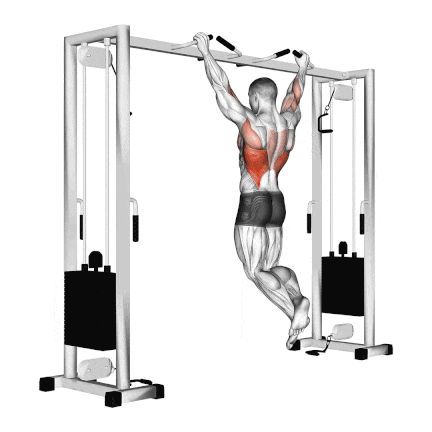
How To Do
- Using an overhand grip, grab a pull-up bar with your hands positioned at shoulder-width apart.
- Hang from the bar with your arms fully extended and your chest high, while exaggerating the arch in your lower back.
- Pull yourself up by squeezing your shoulder blades together and contracting your lats until your chin passes the bar.
- Hold the contraction at the top for a second before slowly lowering yourself back to the starting position.
- Go with the full range of motion and keep the form correct.
- Avoid making sudden, uncontrolled movements.
2. Inverted Row
One of the best things about the inverted row is that it primarily uses your body weight. This makes it incredibly accessible, whether you’re at home using a sturdy bar or at the gym with a barbell on a rack. You don’t need fancy equipment to get a solid lat workout.
The inverted row (bodyweight rows) creates a horizontal body position, making it easier to perform. It works the back and shoulder muscles from a different angle and improves upper body strength.
Most people use the Smith machine in the gym for this exercise. You can also do the inverted row at home by lying under a chair and pulling yourself up.
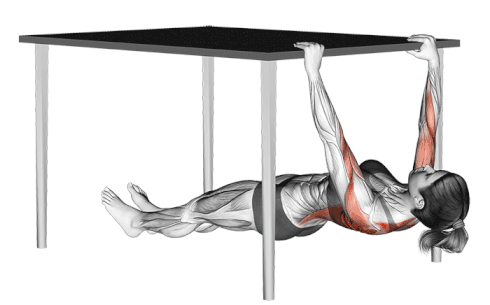
How To Do
- Position yourself under the table, lying on your back and positioning your body so that your upper chest is under the edge of the table.
- Depending on your strength and experience, you can either place your feet flat on the floor with your knees bent (easy version), or straighten your legs and place your heels on the floor (difficult version).
- Raise your arms and grasp the edge of the table with a grip slightly wider than shoulder width.
- From the bottom position, with your arms straight, push yourself up towards the table, keeping your abs tight and your body in a straight line from your heels to your shoulders (from your knees to your shoulders if you are doing the bent knee variation).
- As you come up, open your chest, maintain a straight body position and pull until your chest touches or almost touches the table.
- Lower yourself back down until your arms are almost straight, then repeat the movement until you complete the desired number of repetitions.
3. Superman
The Superman exercise is a bodyweight exercise that primarily strengthens of the muscles of the lats and lower back. However, It also works on your glutes and your hamstring muscles.
It’s a popular exercise in many fitness routines due to its simplicity and effectiveness. The position is named for how it emulates the iconic superhero in flight.
It is accessible and easy to incorporate into any workout because it requires no equipment and little space.
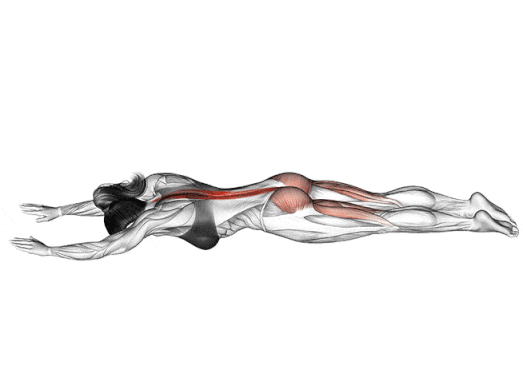
How To Do
- Lie face down on the floor or a mat with your arms extended in front of you and legs straight behind you.
- Simultaneously lift your arms, chest, and legs off the ground as comfortably as possible.
- Think of lengthening and reaching out as you lift, emulating Superman in flight.
- Keep your neck neutral and gaze downwards. Hold the ‘up’ position for a few seconds.
- Slowly lower yourself back down to the starting position.
- Breathe out as you lift and breathe in as you lower.
- Repeat for 10-15 repetitions.
4. Side Plank Rotation
Now, I know what you’re thinking. “Side plank? Isn’t that for abs?” Well, you’re not wrong, but this variation takes things to a whole new level for your lats.
The side plank rotation is a variation of the traditional side plank exercise that targets the obliques, core, back, and glutes
As you rotate your torso and reach under your body, your lats work to help control the movement and stabilize your shoulder girdle.

How To Do
- Start in a side plank with one forearm on the floor, legs stacked, and hips lifted.
- Engage your core and lift your top arm straight up overhead.
- Start the movement by rotating your torso down and sweeping your arm under your body.
- Keep your hips stable and stacked while you touch your hand to the floor.
- Rotate back up to the side plank position. Move slowly and with control.
- Complete reps on one side before switching.
- Start with 3-5 reps per side until you build stability and strength.
5. Supine Bodyweight Floor Row
This move works your lats. As you row, your shoulders work hard to stay still. This helps improve shoulder stability and strength.
Another unique benefit? This is a great core workout. You’re essentially holding a reverse plank position while you row. The first time I did these, I was shocked at how much I felt it in my abs the next day. It’s like getting two exercises for the price of one.
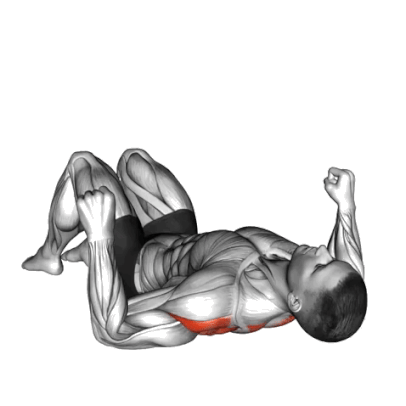
How to Do
- Lie on your back on the floor with your feet flat and knees bent.
- Place your elbows on the floor at about a 45-degree angle from your body, and keep your hands in a neutral position.
- Position your body so that it is in a straight line from your head to your feet.
- Push through your elbows to lift your hips and torso off the ground, squeezing your shoulder blades together as you pull your body upward.
- Lower your body back to the floor with control.
Lat Exercises at Home – Minimal Equipment Needed
You don’t need a fully decked-out home gym to sculpt strong, defined lats. With just a few simple pieces of equipment, you can work your lats from all angles right from your living room.
In this workout, we’ll use resistance bands and dumbbells to hit every part of lat muscles. These exercises will help you build a V-taper and a wide, muscular back.
6. Resistance Band Pull-Aparts
Resistance Band Pull-Aparts are a straightforward, yet highly effective exercise designed to target the muscles in the upper back, especially the lats, rhomboids and rear deltoids.
It can be done anywhere without any setup, making it a great addition to gym and home workouts.
The study has demonstrated that resistance training using elastic devices offers strength gains comparable to conventional equipment. The cost-effective, easy-to-handle elastic devices for strength maintenance and enhancement are suitable for various settings.
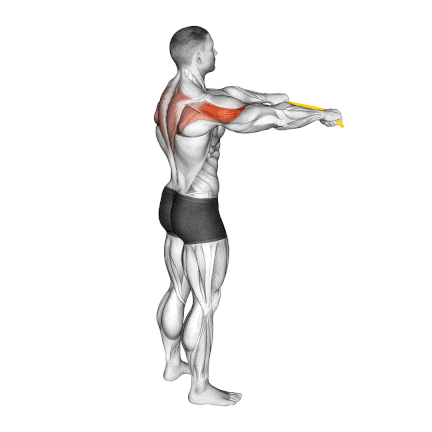
How to Do
- Stand tall with a neutral spine. Hold a resistance band with both hands in front of you, arms extended.
- The hands should be shoulder-width apart or slightly wider, depending on your desired resistance level.
- To separate the band, move your hands away from each other and squeeze your shoulders together.
- Hold the position for a few seconds, then slowly return to the starting position.
- Repeat for 10–15 repetitions.
Tips
- Avoid letting the band snap back quickly.
- Think of pinching a pencil between your shoulder blades as you pull the band apart.
- Start with a small range of motion and gradually increase it as you get stronger.
7. Bands Lat Pulldown
The resistance band lats pulldown can be done anywhere, so it’s a good option for home workouts or while travelling.
It is a compound exercise that engages multiple muscle groups of the back, specifically the latissimus dorsi (lats) and teres major.
A cross-over study found that elastic resistance bands are a viable option to conventional resistance training equipment for lateral pull-downs and unilateral rows.

How To Do
- Attach the resistance band to a sturdy anchor point above your head, such as a door frame.
- Stand facing the anchor point and grasp the resistance band with an overhand grip.
- Step back to create tension in the band. Engage your core and slightly lean back.
- Pull the band down towards your chest. Squeeze your shoulder blades together at the end of the movement.
- Slowly release the tension and return to the starting position.
- Repeat for the desired number of repetitions.
Tips
- Do 3-4 sets of 10-12 repetitions of resistance band lat pulldowns.
- Focus on pulling with your back muscles rather than relying on your arms.
- Make sure you control the movement both on the way down and up.
8. Face Pull with Resistance Band
Face pulls with a resistance band are a great back exercise for strengthening the muscles of the lats, trapezius and rear deltoids.
If you find the traditional face pulls too challenging, you may consider modifying the exercise by using a lighter resistance band or performing it with your knees bent.

How To Do
- Anchor the band at shoulder height and stand holding the handles.
- Maintain an upright posture – don’t lean back.
- Pull the handles toward your face with elbows flared out.
- Squeeze shoulder blades together as you pull. Avoid shrugging or raising your shoulders.
- Slowly return to the start position. Control the motion – no momentum or swinging.
- Complete 10-15 reps.
9. Renegade Row
The renegade row is a full-body dumbbell exercise that targets the primary muscle groups of the lats, shoulders, and core while also engaging the triceps, biceps, and legs.
Renegade rows increase hypertrophy, enhance muscular control, and help build a stronger muscle and mind connection.
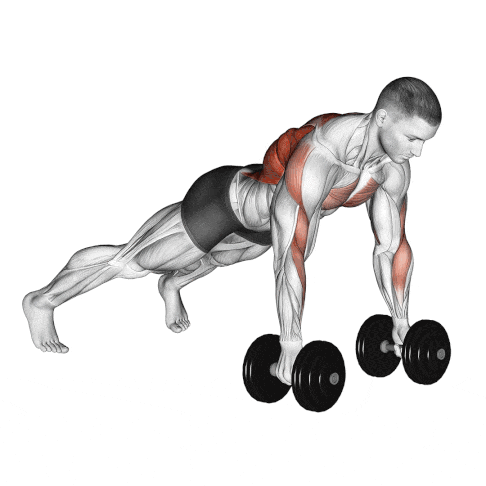
How To Do
- Start in a high plank position with a dumbbell or kettlebell in each hand, directly below the shoulders.
- Engage your core and maintain a neutral spine by squeezing your glutes and keeping your hips level.
- Raise one dumbbell from the ground, rowing it towards your hip by bending the elbow and squeezing the shoulder blade.
- Pause at the top of the row for a second to ensure full muscle activation.
- Slowly lower the dumbbell back to the ground. Move slowly and focus on stability over speed.
- Repeat on the other side, alternating back and forth.
10. Single-arm Dumbbell Row
The single-arm dumbbell row is a compound exercise that works multiple muscle groups simultaneously, including the lats, rhomboids, teres major, and biceps. It is great for building strength and muscle mass in the upper back and shoulders.
As it’s performed one arm at a time, it helps identify and rectify muscle imbalances between the two sides of the body.
It can be done with household items anywhere, from a gym to a home.
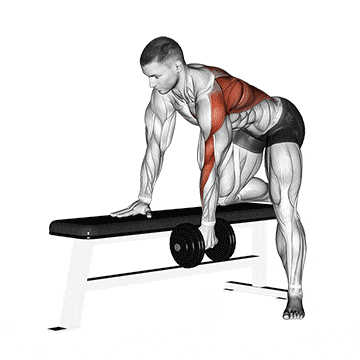
How To Do
- Start by positioning a bench horizontally in front of you.
- Place one knee and the hand on the same side on the bench. Your back should form a tabletop position parallel to the ground. The opposite foot remains firmly on the ground, slightly staggered back.
- Hold a dumbbell in your free hand, palm facing your body. Let the arm holding the dumbbell hang naturally.
- Pull the dumbbell upwards by driving your elbow towards the ceiling. Ensure the movement comes from the back muscles, especially the lats and traps.
- At the peak of the movement, squeeze your shoulder blades together.
- Slowly lower the dumbbell back to the starting position.
- Repeat for 10–12 repetitions, then switch sides.
Tips for Effective Lat Training at Home
1. Incorporate a variety of exercises
Many different exercises target the lats, so mixing things up is important to keep your workouts challenging and engaging—some great exercises to try to include pull-ups, resistance band lat pull-downs, and dumbbell pullovers.
2. Consistent Training
Consistency is crucial for noticeable improvements. Aim to target your lats at least 1-3 times a week.
| Trainee Level | Frequency (per week) | No. of Exercises | Sets | Reps |
|---|---|---|---|---|
| Beginner | 1-2 times | 1-2 | 3-4 | 10-12 |
| Intermediate | 2-3 times | 2-3 | 3-4 | 8-12 |
| Advanced | 3-4 times | 3-4 | 4-6 | 6-10 |
3. Mind-Muscle Connection
Focus on the lats when performing exercises. Think about the muscles you’re targeting and mentally contract them during each rep. This can help ensure that you’re engaging the lats effectively.
4. Progressive Overload
Over time, increase the resistance or number of repetitions to challenge your muscles continually. This principle ensures that the muscles adapt and grow stronger.
5. Rest and Recovery
Give your lats adequate time to recover between workouts. Overtraining can hinder progress and lead to injuries.
At-Home Lats Workout Plan Without Equipment
Adjust the sets and reps based on your fitness level. If it’s too challenging, reduce the reps or sets. If it’s too easy, increase them or slow down the repetitions for increased time under tension.
| Exercise | Sets | Reps |
|---|---|---|
| Pull-ups (or towel pull-ups) | 4 | 8-10 |
| Inverted rows | 3 | 10-12 |
| Supermans | 3-4 | 10-15 |
| Scapular Push-Ups | 3-4 | 10-15 |
Note: If you don’t have access to a pull-up bar, you can substitute towel pull-ups or inverted rows.
Lat Workout At Home With Resistance Band
| Exercise | Sets | Reps |
|---|---|---|
| Single-arm dumbbell rows | 4 | 10-12 |
| Resistance band lat pull-downs | 3-4 | 10-15 |
| Renegade rows | 4 | 8-10 |
| Bands Lats Pulldowns | 3-4 | 10-15 |
Conclusion
Working your lats is critical for building an impressive, v-shaped upper body. A wide, muscular back contributes to overall strength and a sculpted physique.
As we’ve talked about, you can effectively train your lats at home with just your bodyweight and minimal equipment. If you try these workouts, you will find that you can make your lats bigger even if you don’t have a gym.
Just remember that consistency over time and dedication to proper form are key. Don’t get discouraged by setbacks.
References
- Krzysztofik, M.; Wilk, M.; Wojdała, G.; Gołaś, A. Maximizing Muscle Hypertrophy: A Systematic Review of Advanced Resistance Training Techniques and Methods. Int. J. Environ. Res. Public Health 2019, 16, 4897.
- Lopes, J. S. S., Machado, A. F., Micheletti, J. K., Almeida, A. C., Cavina, A. P., & Pastre, C. M. (2019). Effects of training with elastic resistance versus conventional resistance on muscular strength: A systematic review and meta-analysis. SAGE Open Medicine, 7, 2050312119831116. https://doi.org/10.1177/2050312119831116
- Lehman, G. J.; Buchan, D. D.; Lundy, A.; Myers, N.; Nalborczyk, A. Variations in muscle activation levels during traditional latissimus dorsi weight training exercises: An experimental study. Dyn. Med. 2004, 3, 4.

Manish is a NASM-certified fitness and nutrition coach with over 10 years of experience in weight lifting and fat loss fitness coaching. He specializes in gym-based training and has a lot of knowledge about exercise, lifting technique, biomechanics, and more.
Through “Fit Life Regime,” he generously shares the insights he’s gained over a decade in the field. His goal is to equip others with the knowledge to start their own fitness journey.

Agree with the benefits of these exercises but the article is called “10 Best Lat Exercises You Can Do At Home Without Equipment” and 9 of the 10 exercises require equipment…
Correction: I meant 7 out of the 10
Yes, You are right. When creating this list of exercises, my main focus was to help the reader train the lats with minimal equipment.
If you want only bodyweight lat/back exercises, please read below post..
https://fitliferegime.com/15-best-bodyweight-back-workout-beginner-to-advanced/
Thanks for the feedback.